Not a stone has been left unturned on the political landscape
Weizmann Hamilton, Workers’ and Socialist Party (WASP)
Under severe pressure from the families of the victims of the Marikana massacre and threats of legal action, President Jacob Zuma has released the report of the Farlam Commission of Inquiry.
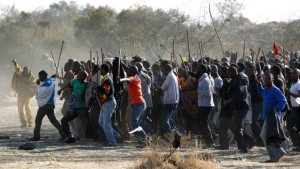
Not unexpectedly, the report completely exonerates the government, specifically: Deputy President Cyril Ramaphosa and former Police and Minerals & Energy Ministers Nathi Mthethwa and Susan Shabangu respectively. Lonmin PLC, the owner of the platinum mine where the strike took place, has been rapped over the knuckles with a feather. It had not used its “best endeavours to resolve disputes between itself and striking workers”, had not “responded appropriately to the threat of violence”, and must bear “a measure of responsibility for the deaths and injuries of its employees”. Only a measure for a company that had summonsed the armed might of the state to settle a labour dispute! Lonmin not only ignored its housing responsibilities in terms of its mining license, but falsified reports of its redirection of funds for social responsibilities, and engaged in tax evasion and the subversion of exchange control regulations. There is not even the suggestion of compensation for the victims’ families, nor any comment on the blatant violation of its dispute resolution procedures.
As is customary with such inquiries the foot soldiers have to fall on their swords for the establishment – the government and the bosses. Such was the weight of the evidence of state culpability that it was impossible not to make recommendations for investigation into criminal liability against the police involved in the shootings.
As for the top brass, it will be public humiliation only, with recommendations that the president institute inquiries into the fitness to hold office of National Police Commissioner, Riah Phiyega, and North West Provincial Commissioner Zukiswa Mbombo, both the first women to hold such senior positions in the police service. In anticipation of the commission’s outcome, Mbombo, who was caught on video as saying “today [16th August] we end this thing”, took the precaution of going on pension when her retirement was due two months ago. Phiyega, appointed to the position by Zuma despite no policing experience, told police the day after the massacre that they should have no regrets about their actions; they had acted in the service of their country.
In the most shocking attempt at holding the workers responsible for the massacre, the commission found that the actions of the workers – singing provocative songs and arming themselves with weapons (machetes, traditional sticks etc.) – had contributed to the massacre. The commission therefore recommended that the NDPP investigate possible criminal prosecutions for the ten deaths that took place in the days leading up to massacre, implying the workers were responsible.
The facts around these ten deaths are that the majority, six, were workers. Two were police and two private security officers deployed as is customary on the mines during strikes, to force the workers back to work under threat of gun fire. These deaths have in any case already been investigated by the police with no outcome.
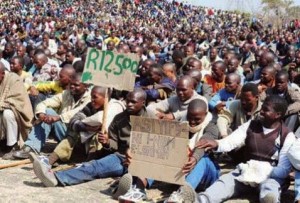
In fact it was from these clashes, which occurred on the company premises, that the workers drew the conclusion that it was unsafe to continue to remain on the mine itself and to retreat to the nearby Loskop Hill, where it would be possible for them to identify any attackers and to protect themselves. There they stayed determined to remain until their simple demand that management should meet them there over their demand for a R12 500 minimum wage was met.
Farlam’s report is a prime example of the fact that the principle of bourgeois judicial “impartiality” is a myth built on the foundation of class law which in the final analysis, is to protect the property and wealth of the rich. The report is riddled with references to the aggressive, threatening behaviour of workers doing no more than singing and toy-toying (a rhythmic marching dance). In circumstances where the vital interests of the capitalist state come into collision with the simple demands of workers to be treated like human beings and be paid a living wage, in the eyes of a bourgeois judge, it is the interests of the former that invariably prevails.
But even as a pretence at impartiality, Judge Farlam’s report completely fails to dispense culpability with even a semblance of equity. In a conflict between victim and perpetrator, between 3 000 workers armed for self defence with nothing more than traditional weapons, and 3000 police from nine different units including what used to be called the Riot Squad under apartheid, now euphemistically given the “democratic” name – Tactical Response Team, the judge offers the workers nothing and the tops of state and the bosses the equivalent of an amnesty. This was a stand-off between workers who had laid down their tools, refusing to continue to be exploited like slaves, and seeking a peaceful resolution of a labour dispute on the one side, and the aggression of police deployed with pre-mediated murderous intent, armed with riot shields, water cannon, armoured vehicles, hand guns, automatic rifles, and helicopters ferrying snipers and razor wire.
Farlam gives post-facto justification to the central aim of the police operation – the disarming of the workers, criticising the police only for the timing of the operation and the manner of its execution. The best time to have implemented this operational plan would have been the morning after to minimise bloodshed, says the worthy judge. The disarming of workers who posed no threat to anyone, who gathered at a hill away from both the mine premises and the nearby squatter camp where those not accommodated in the barracks otherwise known as hostels lived, who were exercising the constitutional right to strike and who stayed on the hill for their own protection, was a legitimate operational objective – the slaughter that ensued was merely the unfortunate result of bad timing and the breakdown of the chain of command on the day.
Buried inside the Commission’s recommendations for corrective measures — riot control training, a review of standing orders, the fitting of helicopters with cameras and greater circumspection in the decisions on what arms police may possess during such operations! – is a recommendation that would be hilarious if it were no so callous: first aid training for all police officers. Presumably this is so that when police shoot down the defenceless, they should attend to their victims themselves. The reality is that the police left them there to die for a full hour, barring emergency vehicles from attending to the dead and wounded as well as the mortuary vans – the presence of which constitutes amongst the most damning evidence of premeditation. The commission could find only one person that might have survived the hour the police waited for them to die whilst they contaminated the scene and planted weapons next to dead bodies as ’before-and-after’ pictures that emerged soon afterwards showed. This is the weight the commission attached to the loss of working class lives.
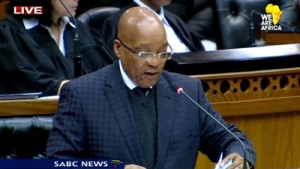 No reference, at least in Zuma’s executive summary, is made to the fact that that in neither of the two scenes of the massacre could any justification be given for the slaughter. The first burst of gunfire at scene one captured by the world’s television cameras and which claimed the lives of seventeen miners in eight seconds, occurred after workers, realising that they were about to be massacred, were led down the hill by the ‘Man in the Green Blanket’, Mgcineni Nkokeni. After observing the aggressive manner of the police deployment, he advised it was better to avoid bloodshed, descend the hill and return to the squatter camp where they lived. The workers were instead ‘kettled’ with razor wire and driven in the direction of the waiting police who gunned them down in cold blood.
No reference, at least in Zuma’s executive summary, is made to the fact that that in neither of the two scenes of the massacre could any justification be given for the slaughter. The first burst of gunfire at scene one captured by the world’s television cameras and which claimed the lives of seventeen miners in eight seconds, occurred after workers, realising that they were about to be massacred, were led down the hill by the ‘Man in the Green Blanket’, Mgcineni Nkokeni. After observing the aggressive manner of the police deployment, he advised it was better to avoid bloodshed, descend the hill and return to the squatter camp where they lived. The workers were instead ‘kettled’ with razor wire and driven in the direction of the waiting police who gunned them down in cold blood.
If initial television pictures at scene one gave the misleading impression of aggressive intent by the workers as they were forced towards the police lines carrying their traditional weapons, events fifteen minutes later at scene two, five hundred metres away from the hill where workers had gathered, left absolutely no doubt about the intention of the police to slaughter the workers.
After witnessing the slaughter at scene one, and with their way to the squatter camp barred by the police, workers fled up the hill to hide between rocks and under bushes. ‘Evidence leaders’ (at the commission hearings) described the actions of the police as a “free for all”. Their actions appeared to have been perpetrated with impunity, and with scant regard for standing orders that require warnings before the use of live ammunition and for the lower body to be targeted.
“Much of the killing was carried out with execution-style precision: of the 17 miners shot dead at what became known as scene two, four had bullet wounds in the head or neck. Nine of them were shot like fish in a barrel while trapped in a natural enclosure among the rocks and bushes.
“In a statement to the commission one miner, Nkosikhona Mjuba, who survived scene two, said: “The police officers started shooting the mineworkers with long and short firearms. Some mineworkers put their hands [in the air] to show they weren’t fighting [or] attacking, but they were shot. Shadrack Matshamba, a rock-drill operator at Marikana’s Four belt shaft, huddled between two rocks…witnessed another miner being mown down while surrendering. He testified that ‘one protestor suggested that we should come out of the hiding place with our hands up…Guys let’s surrender. He then went out of the group with his hands raised. He was shot on his hands or arms. He kneeled down and, as he tried to stand up, still with his hands up, he was shot in the stomach and he fell down. He then tried to stand up but he was shot at again and he fell down. He tried to crawl but he could not do so.”
The Mail & Guardian (26 June – 2 July 2015)
Families of the victims have understandably reacted with outrage and cynicism at the report. In the three years since the massacre, the government has piled onto the injury of the murders of their husbands, fathers and sons, the insult of reneging on the promise to avail the report to them 48 hours before its public release. What confidence can they have in a police force whose initial reaction to the massacre was to arrest and charge the survivors of the massacre with the murder of their comrades under the notorious Doctrine of Common Purpose law that survives on the stature books from the apartheid era, and whose investigations into the deaths of all ten pre-Marikana deaths has failed to produce a single arrest or conviction?
Instead there was a conspiracy reaching to the tops of the police senior command structures to cover up by planting and manipulating evidence at the scene, doctoring the video tapes, concealing written and taped minutes of police planning meetings and giving false testimony to the Commission. Yet the Commission failed to recommend perjury charges against senior police for lying to the commission about when the decision to implement the operation had been made, admitting under cross examination that the final decision had been taken the day before the massacre and not on the day itself as they initially testified.
The elaborate efforts by the state to cover up the Marikana massacre, of which the Farlam Commission is but the latest and most ignominious attempt, will in all likelihood succeed in shielding the government, Lonmin, and particularly the ministers at the heart of the operations to crush the strike — deputy president and Lonmin shareholder and director Cyril Ramaphosa, Ministers Nathi Mthethwa and Susan Shabangu, accusations of responsibility against whom the Commission found to be “groundless,” and behind them president Jacob Zuma and his cabinet.
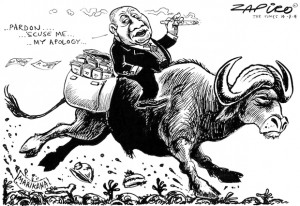
Evidence at the commission showed incontrovertibly that tycoon Ramaphosa, the first general secretary of the National Union of Mineworkers – who personally offered the families R3m in compensation weeks after he offered to pay R19m for a prize bull at an auction –in particular was the central figure in the attempt to end the strike, and was in constant communication with mine management, the police and the cabinet. He set the tone for the massacre with his infamous email to the Mining and Energy Minster declaring the strike “a criminal act that must be dealt with concomitantly.” It is inconceivable that a decision to carry out the worst massacre since the Sharpeville massacre by the apartheid regime in 1960 which claimed the lives of 69 black people shot by the police for protesting in front of a police station against the passbook (documents blacks in urban blacks areas were required to carry on their persons all the time and produce on demand by the police or face arrest and deportation out of the cities to the bantustans) was taken without the knowledge and consent of the president.
Marikana a watershed
What the establishment will not be able to prevent, however, is the political fall-out from the massacre. Firstly if the Commission was set up in the hope of closing the door on this chapter once and for all, it will only open the sluice gates for further litigation including civil claims against Lonmin, the government and possibly Ramaphosa.
Marikana, however, was far more than a simple labour dispute “tragically” mishandled. It was a political earthquake the after-shocks of which continue to rock the political establishment, the latest development of which is the SA Communist Party’s (SACP’s) renunciation of Zuma whose support for him in the toppling of Thabo Mbeki in 2007/8 they now claim was a mistake.
From the onset, the strategist of the ruling class understood that this was no ordinary strike over wages, outlandish as they considered the demand for a R12 500 minimum wage to have been. In an editorial comment extraordinary for its naked language of class war, Business Day (17 Aug 2015) was forthright in its analysis of the implications of the strike calling upon the entire ruling class to rally behind the “venerable” National Union of Mineworkers, a union that “understands capital” and warning the “ruling political establishment of the ANC, SACP and COSATU” that they faced a force without respect for it and over which they had no control.
Often the Marxists come to the same conclusion as the strategists of capital – but from the opposite class standpoint. The Democratic Socialist Movement, co-founders of the Workers and Socialist Party, and the only left force to intervene in these tumultuous events, had been present in Rustenburg for three years before Marikana, anticipating that the chain of working class illusions in the post-apartheid dispensation would break at its strongest link – the NUM, at that time the biggest, richest and politically most influential of COSATU’s affiliates. We understood that the mining industry, despite its relative decline in the share of the country’s Gross Domestic Product, was historically the economic and political backbone of South African capitalism – the weight of its political influence as the vanguard of the capitalist class far exceeding its present day economic role.
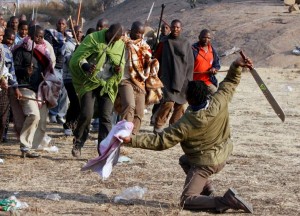
We understood therefore that because the strike of the Lonmin workers was led by an independent strike committee, it was in fact a rebellion not only against their exploitation in an industry in which it would take the average mine worker 300 hundred years to earn what a CEO earns in one year, but against the NUM. It was an expression of the realisation that the NUM had degenerated into collaborators with the mining bosses in protecting the rule of the bosses in the mining industry, based as it was on the oppressive migrant labour system which had been in place for over a hundred years and which the apartheid system had inherited from colonialism and developed to support the capitalist system, the management of which the ANC took over when it came to power.
Because the NUM was the powerhouse of COSATU, and because COSATU in turn was the most important ally of the ANC in the Tripartite Alliance with the ANC and SACP, this was in reality an unarmed political uprising against the entire political establishment whose political takeover had been so carefully put together at the negotiated settlement reached at CODESA (Congress for a Democratic South Africa). CODESA had put an end to white minority rule and ushered in majority rule based on parliamentary democracy but with the central strategic objective of preserving the economic dictatorship of capitalism under the mask of bourgeois parliamentary democracy.
From these events, we concluded, the working class would draw the most profound conclusions. The working class sometimes arrives at an understanding from the significance of a single event, what they had apprehended incrementally in their consciousness over decades from a succession of events which individually did not reveal their significance. The Marikana massacre we pointed out, illuminated with blinding clarity the implications of the successive betrayals of the ANC over the previous 18 years.
What the editor of Business Day had understood immediately after Marikana, the workers understood also at the same time. The ANC had revealed itself as the party of the mining bosses and the broader capitalist class; the state had revealed itself as the armed guardians of the dictatorship of capital; COSATU and the SACP had betrayed themselves as the collaborators of the capitalist class and their political management team, the ANC in the perpetuation of working class slavery.
It was not enough, however, for the DSM to be able to read the message in the tea leaves. The success of the socialist revolution requires the consummation of the marriage between the objective and the subjective factors – the coming together of the objective process of the socialist revolution the masses had embarked on to overthrow the existing political order without a clear idea of what to replace it with, and the intervention of the subjective factor – the organisational capability of the conscious forces of Marxism to embed themselves into the elemental movement of the masses.
The DSM, in the personages of Liv Shange and Mametlwe Sebei especially, implemented the programme of the first rule of revolution, the organisation of the unity of the working class on a programme that would empower the masses to first overcome their immediate adversary and ultimately to understand the need to proceed towards the overthrow of capitalism itself. The Lonmin workers were not alone in realising the treachery of the NUM. Across the Rustenburg mining belt, workers had established independent strike committees in virtually every mine. Far from crushing the strike, the Marikana massacre provoked a movement that spread across the Rustenburg mining belt spreading beyond the North West province into the mining industry as a whole in Gauteng, Mpumalanga, Limpopo and the Northern Cape.
The DSM-initiated Rustenburg-wide Joint Strike Coordinating Committee developed into the National Strike Committee. It led at its height a strike of over 100 000 workers in the mining industry, inspiring also the strike of the farm workers in the Western Cape. By year’s end, the decision was made, on 15th December, 2012, between the DSM and a number of strike committees to form the Workers and Socialist Party which was launched on Sharpeville day on 21st March 2013.
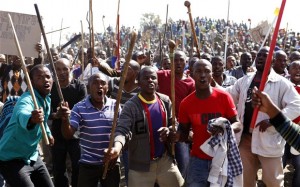
As the DSM has predicted, the Marikana massacre would prove to be the fault line, drawn in the blood of the martyrs of Marikana, between two epochs in the post–apartheid era, the first of illusions in the ANC and bourgeois parliamentary democracy, and the second the era of the breaking of the illusions in the ANC, a break-out from the political prison of the Tripartite Alliance, and the embarkation by the working class on a journey in search of its own class and political independence. Rarely in history has it been possible to identify the commencement of the appearance of the fault line between two historical epochs with the accuracy that the Marikana massacre has enabled historians to do. The old ended at precisely 15:40 on the 16th of August 2013; the new began 8 second later.
Since then, as we predicted, not a stone has been left unturned on the political landscape. The first aftershock of the Marikana earthquake was another major split in the ANC – the second in 5 years; the launch by expelled ANC Youth League president, Julius Malema of the Economic Freedom Fighters on a radical left-populist programme calling amongst other for the nationalisation, without compensation, of the commanding heights of the economy. However, the National Union of Metal Workers of SA (NUMSA)’s historic decisions at its Special National Congress in December 2013 to withdraw support from the ANC in the 2014 elections was an aftershock that registered much higher on the political Richter Scale. In addition to announcing that it would not be campaigning for the ANC in the 2014 general elections, it levelled a searing criticism of the SACP and the pro-Zuma leadership of COSATU, to which it suspended the payment of subscriptions. It resolved to form a workers party, a united front and a movement for socialism.
Although NUMSA, regrettably, did not heed WASP’s call for it to support our election campaign, our decision to stand in the elections had placed the question of socialism in the political mainstream, and sharpened the ideological contours of the debate about socialism.
COSATU reacted to NUMSA’s SNC decisions by expelling it as well as the COSATU general secretary, Zwelinzima Vavi. COSATU, the most powerful, militant and radical trade union federation on the African continent, has now all but disintegrated. The SACP is deeply split with growing calls from within to contest the elections. Although framed as a tactical move to enable the ANC to survive in office through a coalition with it, any such decision will only deepen the divisions further both within the party and the ANC. The Tripartite Alliance has been left in ruins by the Marikana earthquake. The process may lack ideological clarity and coherence and take detours, but the way has now been cleared for the development of a mass workers party. Wasp is campaigning for the formation of a new trade union federation, supporting the united front, building the Socialist Youth Movement and a federation of socialist civics, and campaigning for the unity of these forces in a mass workers party on a socialist programme.


